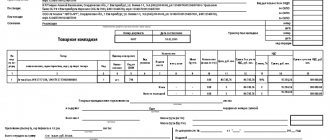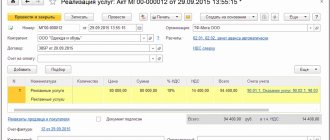What the Ministry of Finance of the Russian Federation says about VAT deduction on a cash receipt
Hidden text
- the goods were purchased at retail (even if the VAT amount is highlighted as a separate line in the cash receipt);
- the company wishes to include VAT as an expense when calculating income tax.
A common situation was considered. An employee is given money on account for the purchase of office supplies, for example. There is no invoice. The employee draws up an advance report and attaches a cash receipt with the VAT amount highlighted on a separate line. The company is wondering whether the accountant has the right to deduct VAT. If this is not possible, then can VAT be included as an expense when calculating the taxable base for income tax?
It should be noted that from July 1, 2021, all sellers of goods and services switched to online cash registers, which means that absolutely all cash register receipts will include information about VAT and the tax rate - this is the requirement of the law “On the use of cash registers”. technology in the Russian Federation."
The Ministry of Finance of the Russian Federation emphasizes that, according to the instructions of paragraph 1 of Art. 172 of the Tax Code of the Russian Federation, VAT can be deducted on the basis of the following documents:
- Invoice issued by the seller.
- Documents proving payment of VAT withheld by tax agents.
- Documents that prove the fact of payment of VAT when importing goods into the territory of the Russian Federation.
- Any other documents in cases where a deduction can be made for VAT paid by the organization as part of entertainment or travel expenses, as well as directly to the budget.
Based on the instructions of paragraph 1 of Article 172 of the Tax Code of the Russian Federation, the financial department concluded that VAT deduction is impossible when purchasing goods at retail. Even the fact that VAT is listed as a separate line on the cash receipt does not allow taxpayers to make a deduction. The Ministry of Finance of the Russian Federation does not allow the accounting of VAT as part of income tax expenses - clause 2 of Art. 170 of the Tax Code of the Russian Federation does not provide for the possibility of including the amount of tax in the cost of goods. But according to paragraph 1 of Art. 170 of the Tax Code of the Russian Federation, in other cases, amounts of value added tax presented at the time of purchase of goods cannot be taken into account as part of income tax costs
.
Procedure for reimbursement of expenses incurred
VAT reimbursement involves reducing the amount of tax accrued for payment upon the sale of goods (work or services) through the use of a deduction.
The procedure for deducting advance payments is as follows:
- The buyer transfers an advance payment to the seller and receives an invoice for the advance payment from him.
- Based on this document, he claims tax for deduction, registering the specified invoice in his purchase book.
- Upon shipment, a shipping invoice is issued, on the basis of which the buyer again claims VAT for deduction.
- And at the same time, it restores for payment to the budget the amount of value added tax claimed for deduction when transferring the prepayment. This action means registering an invoice for an advance payment in the sales book (subclause 3, clause 3, article 170 of the Tax Code of the Russian Federation).
The process of VAT refund from the budget takes place in the following stages:
- Drawing up a declaration with the provision of the necessary package of documents and submitting it to the Federal Tax Service. Necessary documents include: invoices received and issued, invoices for receipt and release, checks and payment orders confirming the fact of payment, a book of purchases and sales, a journal of registration of invoices (the journal is required only for some intermediary companies).
- Conducting a desk tax audit upon submission of the declaration. The results of the inspection are documented in a report indicating violations, if any.
- Receiving funds into the organization's account or paying off other tax obligations from these amounts.
VAT deduction on a cash receipt - the opinion of the courts
The courts turned out to be not as categorical on the issue of deducting VAT on a cash receipt as the Ministry of Finance of the Russian Federation. For example, the Presidium of the Supreme Arbitration Court indicated that when selling goods at retail for cash, the requirements for issuing invoices are recognized as fulfilled when the seller issues the buyer a cash receipt (or other document of the proper form) (clause 7 of Art. 168 of the Tax Code of the Russian Federation). Accordingly, the buyer has the right to deduct VAT if payment for goods was made taking into account value added tax. See Resolution of the Presidium of the Supreme Arbitration Court of the Russian Federation dated May 13, 2008 No. 17718/07, Resolution of the Federal Antimonopoly Service of the Moscow District dated August 20, 2007 No. KA-A40/7956-07.
When is VAT allowed to be deducted?
In the event that an LLC or individual entrepreneur who owns a store pays VAT, the purchase amount will include the amount of value added tax.
If the following conditions are met, input VAT is allowed to be deducted: (click to expand)
- the company has documents indicating the existence of the right to deduct VAT;
- the purchased goods were capitalized on the company’s balance sheet;
- goods were purchased for the purpose of carrying out production activities, resale or any other operations that are subject to value added tax.
As for the first point about the availability of documents proving the right to a tax deduction, this condition previously caused disputes with the Federal Tax Service. The Tax Service believes that the right to deduction is confirmed by only one document - the invoice issued by the seller. See Letter of the Ministry of Science of the Russian Federation dated May 13, 2004 No. 03-1-08/1191/ [email protected] The Ministry of Finance agreed with the decision of the Federal Tax Service, as evidenced by:
- Letter of the Ministry of Finance of the Russian Federation dated August 25, 2017 No. 03-07-14/54643;
- Letter of the Ministry of Finance of the Russian Federation dated January 12, 2021 No. 03-07-09/634;
- Letter of the Ministry of Finance of the Russian Federation dated 06/02/2021 No. 03-07-14/45605.
Important!
At the time of purchasing goods in a store, an invoice issued by the seller is not required. Typically, sellers issue only a sales receipt and a cash receipt.
As stated in the text of paragraph 7 of Art. 168 of the Tax Code of the Russian Federation, in the case of selling goods for cash, the requirements for issuing invoices and drawing up settlement documents are considered fully met if the buyer received a cash receipt or other document of the established form from the seller (for example, a strict reporting form). Accordingly, current tax legislation allows taxpayers to deduct VAT if:
- the product was purchased at a retail outlet;
- the seller did not issue an invoice;
- In the cash register and sales receipt, the VAT amount is highlighted as a separate line.
VAT deduction on a cash receipt - conclusions
When an item is purchased at a retail store for cash, taxpayers are entitled to a VAT deduction based on the sales receipt, even if there is no invoice. The main thing is that the VAT amount is highlighted as a separate line in the goods and the cash receipt.
If a conflict arises with the tax service, you can refer to arbitration practice. The judges are of the opinion that it is impossible to refuse a VAT deduction only because of the absence of an invoice if there is a cash receipt or other document of the established form.
To avoid problems with the Federal Tax Service, whose inspectors refuse to deduct VAT in the absence of an invoice at the time of the on-site inspection, it is better to carry out the purchase and sale operation in special contract departments of retail stores
– specialists will issue an invoice, cash receipt order or invoice to the buyer who paid in cash. When the VAT amount is highlighted as a separate line in the listed documents, VAT can be deducted.
Common mistakes
Error:
The taxpayer accepted VAT as a deduction after purchasing goods for cash in a retail store. In the cash receipt, VAT was not highlighted as a separate line.
A comment:
If the seller did not issue an invoice when purchasing goods at retail, VAT can be deducted on the basis of a sales or cash receipt, but the VAT amount must be highlighted on a separate line.
Error:
The purchased goods were not recorded on the company's balance sheet. The taxpayer accepted VAT for deduction on the basis of a cash receipt with the amount of value added tax highlighted as a separate line.
A comment:
In order to have grounds for deducting VAT, it is necessary to capitalize the purchased goods on the balance sheet of the enterprise, retain documents confirming the right to deduct, resell the goods or use them in the course of production activities or in carrying out other transactions subject to VAT.
Recording the fact of receipt of the document
The fact of receiving an advance invoice must be recorded in the books of purchases and sales by both sellers and buyers.
- The document is registered in the sales book by the seller (performer of the work) upon receipt of an advance payment within 5 calendar days.
- At this moment, the buyer has the right to accept the presented tax, if any, as a deduction, i.e. enters the advance invoice received from the seller into the purchase book.
- Next, the seller ships the goods and records the advance invoice in his sales book in order to deduct VAT.
- The buyer accepts tax for deduction on the shipping invoice, and must recover VAT from the advance payment, for which he registers the advance document previously received from the seller in the sales book (how are invoices registered and stored?).
Answers to common questions about VAT deduction on a cash receipt
Question #1:
Can you be sure that the tax office, during an on-site audit, will not refuse to deduct VAT due to the lack of an invoice?
Answer:
The Federal Tax Service is of the opinion that VAT deductions can only be made if there is an invoice. Therefore, if the taxpayer only has a cash receipt in which VAT is highlighted as a separate line, claims from the tax inspectorate cannot be avoided, despite the fact that the opinion of the arbitration judges does not agree with the position of the Federal Tax Service. The only way to avoid claims is to complete the purchase of goods in a special contract department of the store, where sellers issue an invoice, delivery note and cash settlement for buyers who paid in cash.
Question #2:
There is a cash receipt for the purchase of goods in a retail store. Is it possible to deduct VAT without an invoice if the goods were not purchased for the purpose of using them in the business of the company?
Answer:
It is allowed to deduct VAT on the purchase of goods that were purchased for the purpose of resale or use in the economic activities of the enterprise. If the goods were purchased for other purposes, VAT cannot be deducted in any case.
Postings
Let's look at the main entries for accounting for employee advance reports.
For household needs
- Debit 71 Credit 50 – the employee received an advance.
- Debit 60 Credit 71 – materials purchased.
- Debit 10 Credit 60 – expenses are included in the cost of materials.
- Debit 19 Credit 60 – VAT on purchased materials is taken into account.
- Debit 91.2 Credit 19 – VAT is written off for other expenses.
- Debit 71 Credit 50 – additional payment was made to the employee.
On business trips
- Debit 71 Credit 50/1 – an advance was received for a business trip.
- Debit 19 Credit 71 – VAT included.
- Debit 68 Credit 19 – VAT deducted.
- Debit 44 Credit 71 – business trip expenses are taken into account.
- Debit 50/1 Credit 71 – return of unused funds to the company account.
An invoice is one of the primary accounting documents. This is why a whole section of articles on our website is dedicated to him, by studying which you can learn about:
- how the document is signed;
- what are adjustment and electronic invoices;
- how to cancel a document.







